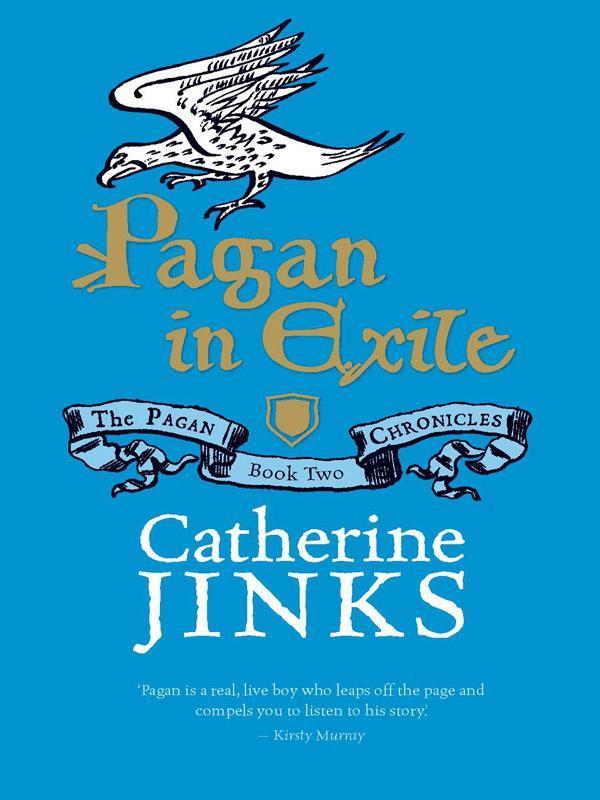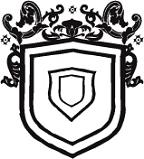Pagan in Exile

T
HE
P
AGAN
C
HRONICLES
‘Full of the richly-textured, high-smelling, highly individualistic atmosphere of the Middle Ages, Catherine Jinks’s Pagan series offers unforgettable characters in an extraordinary setting and time, presented in crisp, pungent prose.’
SOPHIE MASSON
‘Humour, romance, adventure, violence – who would have thought Medieval Jerusalem could be so much fun?’
LILI WILKINSON
‘The Pagan Chronicles are a kind of medieval version of Tin Tin, meticulously researched and told with a delightfully slapstick, cinematographic vigour.’
URSULA DUBOSARSKY
‘What a romp! Not since Don Quixote took up with Sancho Panza has a knight had a squire like Pagan Kidrouk.’
Voice of Youth Advocates
‘There have been few characters in recent historical fiction more vibrant than the street-smart, fast-talking protagonist of this series.’
School Library Journal
‘Rich, vivid storytelling, with a sturdy base in historical events, and undercurrents both comic and serious. ’
Kirkus Reviews
(STARRED REVIEW)
‘Jinks dramatically evokes a historical time that was particularly dark and dirty ... Along with the drama and darkness, readers will find intensity and, yes, humor. Series fans may find other books set in the Middle Ages pallid after this one.’
AMERICAN LIBRARY ASSOCIATION
‘Pagan is a real, live boy who leaps off the page and compels you to listen to his story.’
KIRSTY MURRAY
‘Humour? Rage? Agony? Spiritual journeys? Murder? Moral turpitude? Twists both welcome and dismaying? This decidedly unique historical saga has it all.’
Kirkus Reviews
(STARRED REVIEW)
‘Brimming with wit and fascinating details of medieval history, with its vividly drawn characters ... this emotionally satisfying epic brings the Middle Ages to life.’
The Horn Book
C
ATHERINE
J
INKS
is a scholar of medieval history and a prolific author for teenagers, children and adults. Her books have been published to wide acclaim in Australia and overseas and have won numerous awards. She loves reading, history, films, TV and gossip, and says she could write for eight hours straight every day if she had the chance. Catherine lives in the Blue Mountains of NSW with her husband and daughter.
T
HE
P
AGAN
C
HRONICLES
Pagan’s Crusade
(shortlisted CBCA and Victorian Premier’s Literary awards)
Pagan in Exile
Pagan’s Vows
(winner CBCA Book of the Year Award for older readers)
Pagan’s Scribe
(winner Victorian Premier’s Literary Award for children’s literature)
Pagan’s Daughter
(notable book CBCA Book of the Year Award for older readers)

Catherine
JINKS

The author would like to thank John O. Ward for his assistance.
First published in 1994
This edition published in 2007
Copyright © Catherine Jinks, 1994
All rights reserved. No part of this book may be reproduced or transmitted in any form or by any means, electronic or mechanical, including photocopying, recording or by any information storage and retrieval system, without prior permission in writing from the publisher. The
Australian Copyright Act 1968
(the Act) allows a maximum of one chapter or ten per cent of this book, whichever is the greater, to be photocopied by any educational institution for its educational purposes provided that the educational institution (or body that administers it) has given a remuneration notice to Copyright Agency Limited (CAL) under the Act.
Allen & Unwin
83 Alexander Street
Crows Nest NSW 2065
Australia
Phone (61 2) 8425 0100
Fax: (61 2) 9906 2218
Email: [email protected]
Web:
www.allenandunwin.com
National Library of Australia
Cataloguing-in-Publication entry:
Jinks, Catherine, 1963– .
Pagan in exile.
For ages 12 and over.
ISBN 978 1 74175 232 8 (pbk.).
1. Orphans – Juvenile fiction. 2. Knights and knighthood – Juvenile fiction. 3. Heretics, Christian – Juvenile fiction. 4. France – History – Medieval period, 987–1515 – Juvenile fiction. I. Title. (Series: Jinks, Catherine, 1963– Pagan chronicles; 2).
A823.3
Cover & Text Design by Zoë Sadokierski
Set in Celestia Antiqua 11.5/15pt by Midland Typesetters
Printed in Australia by McPherson’s Printing Group
10 9 8 7 6 5 4 3 2 1
To Rachael Westwood

‘. . . And so it was that, the Kingdom of Jerusalem having fallen to the enemies of Christ in the year of Our Lord’s incarnation 1187, there was great lamentation across many lands, and the Holy Father Pope Gregory beseeched all his valorous subjects to gird themselves manfully, and liberate from the defilement of the Infidel that city in which our Saviour suffered for us. Alas, however, although many were kindled by love of the divine majesty to shed their blood, others brought down God’s final punishment, making war upon fellow Christians when they should have been united in the bonds of peace. Thus did Richard of England, called Lionheart, and the King of France, Philip Augustus, take up the sign of the cross; and thus did they fall upon each other in discord and dissension before they had assembled their crusading armies. Meanwhile, in the region of Languedoc, there arose certain heretics – sons of Baal and witnesses of the anti-Christ – who seduced many simple and weak-minded Christians with the abominable pestilence of heretical depravity. These vessels of Satan, the ‘Cathari’, called their priests ‘Good Men’, and believed that there were two creators: one of the invisible world, whom they called the benign God, and one of the visible world, or the malign God. And by clinging to these monstrous doctrines they infected our holy church, depriving it of divine favour, so that when the crusade was finally fought, the pagan multitudes bore away the glorious palm of victory . . .’
– Simon of Saint Medard, c. 1230

Contents

June, 1188

W
hat’s everybody staring at?
All right, so you’ve never seen an Arab before. Is that any reason to stare? My hair’s not green. My skin’s not blue. It might be darker than yours, but dark skin is quite normal in my country. So I’m short. So what? I’m not that short. I’m tall enough to see over my own knees. Anyone would think I had a giant candle-snuffer growing out of my forehead.